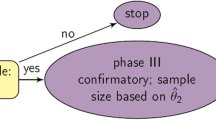Abstract
We consider hypothesis testing in a clinical trial with an interim treatment selection. Recently, unconditional and conditional procedures for selecting one treatment as the winner have been proposed when the mean responses are approximately normal. In this paper, we generalize both procedures to multi-winner cases. The distributions of the test statistics are obtained and step-down approaches are proposed. We prove that both unconditional and conditional procedures strongly control the family-wise error rate. We give a brief discussion on power comparisons.
Similar content being viewed by others
References
FDA (2008) Guidance for industry: diabetes mellitus: developing drugs and therapeutic biologics for treatment and prevention
Friede T, Stallard N (2008) A comparison of methods for adaptive treatment selection. Biom J 50:767–781
Kelly PJ, Stallard N, Todd S (2005) An adaptive group-sequential design for Phase II/III clinical trials that select a single treatment from several. J Biopharm Stat 15:641–658
Koenig F, Brannath W, Bretz F, Posch M (2008) Adaptive Dunnett tests for treatment selection. Stat Med 27:1612–1625
Lan KKG, Soo Y, Shun Z (2005) Normal approximation for two-stage winner design. In: Hsiung AC, Ying Z, Zhang CH (eds) Random walks, sequential analysis and related topics. World Scientific, Singapore, pp 28–43
Li G, Zhu Z, Ouyang SP, Xie J, Deng L, Law G (2009) Adaptive designs for interim dose selection. Stat Pharm Res 1:366–376
Liu Q, Peldger GW (2005) Phase 2 and 3 combination designs to accelerate drug development. J Am Stat Assoc 100:493–536
Marcus R, Peritz E, Gabriel KR (1976) On closed testing procedures with special reference to ordered analysis of variance. Biometrika 63:655–660
Sampson AR, Sill MW (2005) Drop-the-losers design: normal case. Biom J 47:257–268
Shun Z, Lan KKG, Soo Y (2008) Interim treatment selection using the normal approximation approach in clinical trials. Stat Med 27:597–618
Sill MW (2000) Estimation and inference for drop-the-losers designs. Ph.D. Dissertation, Department of Statistics, University of Pittsburgh, PA, USA
Stallard N, Todd S (2003) Sequential designs for Phase III clinical trials incorporating treatment selection. Stat Med 22:689–703
Stallard N, Friede T (2008) A group-sequential design for clinical trials with treatment selection. Stat Med 27:6209–6227
Thall PF, Simon R, Ellenberg SS (1988) Two-stage selection and testing designs for comparative clinical trials. Biometrika 75:303–310
Thall PF, Simon R, Ellenberg SS (1989) A two-stage design for choosing among several experimental treatments and a control in clinical trials. Biometrics 45:537–547
Todd S, Stallard N (2005) A new clinical trial design combining Phases 2 and 3: Sequential designs with treatment selection and a change of endpoint. Drug Inf J 39:109–118
Whitehead J (1986) Sample size for Phase 2 and Phase III clinical trials. Stat Med 5:459–464
Whitehead J (1997) The design and analysis of sequential clinical trials, 2nd edn. Wiley, Chichester
Author information
Authors and Affiliations
Corresponding author
Rights and permissions
About this article
Cite this article
Li, G., Wang, Y. & Ouyang, S.P. Interim Treatment Selection in Drug Development. Stat Biosci 1, 268–288 (2009). https://doi.org/10.1007/s12561-009-9017-y
Received:
Accepted:
Published:
Issue Date:
DOI: https://doi.org/10.1007/s12561-009-9017-y




